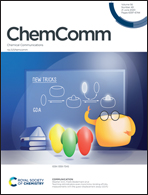Is breaking of a hydrogen bond enough to lead to drug resistance?†
Abstract
Drug resistance is a serious problem in cancer, viral, bacterial, fungal and parasitic diseases. Examination of crystal structures of protein–drug complexes is often not enough to explain why a certain mutation leads to drug resistance. As an example, the crystal structure of the kinase inhibitor dasatinib bound to the Abl1 kinase shows a hydrogen bond between the drug and residue Thr315 and very few contacts between the drug and residues Val299 and Phe317, yet mutations in those residues lead to drug resistance. In the first case, it is tempting to suggest that the loss of a hydrogen bond leads to drug resistance, whereas in the other two cases it is not known why mutations lead to drug resistance in the first place. We carried out extensive molecular dynamics (MD) simulations and free energy calculations to explain drug resistance to dasatinib from a molecular point of view and show that resistance is due to a multitude of subtle effects. Importantly, our calculations could reproduce the experimental values for the binding energies upon mutations in all three cases and shed light on their origin.



 Please wait while we load your content...
Please wait while we load your content...